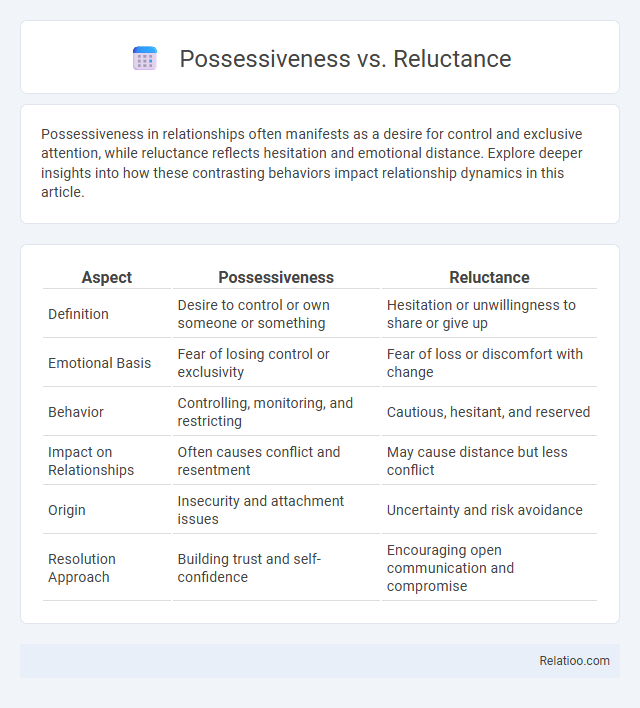Possessiveness in relationships often manifests as a desire for control and exclusive attention, while reluctance reflects hesitation and emotional distance. Explore deeper insights into how these contrasting behaviors impact relationship dynamics in this article.
Table of Comparison
| Aspect | Possessiveness | Reluctance |
|---|---|---|
| Definition | Desire to control or own someone or something | Hesitation or unwillingness to share or give up |
| Emotional Basis | Fear of losing control or exclusivity | Fear of loss or discomfort with change |
| Behavior | Controlling, monitoring, and restricting | Cautious, hesitant, and reserved |
| Impact on Relationships | Often causes conflict and resentment | May cause distance but less conflict |
| Origin | Insecurity and attachment issues | Uncertainty and risk avoidance |
| Resolution Approach | Building trust and self-confidence | Encouraging open communication and compromise |
Understanding Possessiveness: Definition and Traits
Possessiveness is a behavioral trait characterized by an intense desire to control or dominate someone or something, often stemming from insecurity or fear of loss. Understanding possessiveness involves recognizing signs such as jealousy, controlling actions, and a constant need for reassurance, which can negatively impact relationships. Being aware of these traits helps you manage possessiveness constructively and fosters healthier emotional connections.
Exploring Reluctance: Meaning and Key Characteristics
Reluctance refers to an unwillingness or hesitation to engage in a particular action or decision, often driven by uncertainty, fear, or doubt. Key characteristics of reluctance include a cautious approach, internal conflict, and a tendency to delay or avoid commitment. Exploring reluctance reveals its role as a psychological barrier that impacts decision-making and behavior in various personal and professional contexts.
Psychological Roots of Possessiveness
Possessiveness often stems from deep-seated insecurities and attachment anxieties rooted in early developmental experiences or trauma, which trigger fears of abandonment and loss. This psychological need to control or claim ownership over people or objects serves as a defense mechanism to maintain emotional security and self-worth. In contrast, reluctance typically arises from hesitation or uncertainty, often linked to risk assessment and decision-making processes rather than underlying attachment issues.
What Causes Reluctance in Relationships?
Reluctance in relationships often stems from fear of vulnerability, past emotional trauma, or lack of trust, which hinders open communication and emotional intimacy. Emotional wounds from previous relationships can create protective barriers, causing hesitation to fully engage or commit. Understanding these causes allows you to address underlying issues and foster a healthier, more trusting connection.
Possessiveness vs Reluctance: Core Differences
Possessiveness reflects a desire to control or keep exclusive ownership over someone or something, often driven by fear of loss or insecurity. Reluctance involves hesitation or unwillingness to engage, stemming from doubt or discomfort rather than control. Understanding your emotional responses helps distinguish whether your behavior is rooted in possessiveness or reluctance, which can improve personal relationships and decision-making.
Emotional Impacts on Partners
Possessiveness often leads to feelings of suffocation and mistrust in partners, negatively impacting emotional security and intimacy. Reluctance, characterized by hesitation or avoidance, can cause confusion and emotional distance, undermining open communication and connection. Both emotional responses disrupt relationship harmony, but possessiveness generates anxiety while reluctance fosters uncertainty, challenging partners' emotional well-being in distinct ways.
Recognizing the Signs Early
Recognizing the signs of possessiveness, reluctance, and resistance early is crucial for maintaining healthy relationships and personal boundaries. Possessiveness often manifests as controlling behavior and jealousy, while reluctance shows through hesitation and avoidance, and resistance appears as outright refusal or opposition to change. Being aware of these distinct emotional responses can help you address underlying issues promptly and foster better communication.
How Possessiveness and Reluctance Affect Communication
Possessiveness in communication often leads to controlling behaviors and limits open dialogue, creating barriers to mutual understanding and trust. Reluctance manifests as hesitation or avoidance in expressing thoughts and feelings, resulting in incomplete or unclear messages that hinder effective interaction. Both possessiveness and reluctance negatively impact communication by reducing transparency and emotional openness between individuals.
Strategies for Healthy Boundaries
Setting healthy boundaries involves recognizing the difference between possessiveness, which often stems from insecurity, and reluctance, which may arise from caution or past experiences. You can develop strategies such as clear communication, self-awareness, and mutual respect to maintain balance and prevent possessiveness from hindering relationships. Prioritizing personal space while respecting others' autonomy fosters trust and emotional well-being in any interaction.
Moving Forward: Cultivating Balanced Relationships
Cultivating balanced relationships requires navigating possessiveness, which often stems from insecurity, and reluctance, marked by hesitance or fear of vulnerability. Moving forward involves fostering trust and open communication to transform possessiveness into reassurance and reluctance into willingness. Prioritizing emotional awareness and mutual respect promotes healthy boundaries and deeper connections.

Infographic: Possessiveness vs Reluctance
 relatioo.com
relatioo.com